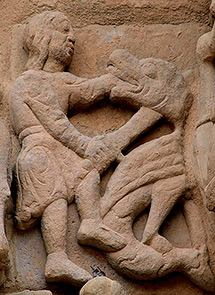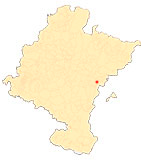The Gateway of Santa María de Sangüesa
By Clara Fernández-Ladreda Aguadé
|
THE ARTISTS. THE WORKSHOP OF SAN JUAN DE LA PEÑA AND THE WORKSHOP OF SCHEMATIC FIGURES |
|
The artists. The workshop of San Juan de la Peña and the workshop of the schematic figures.
The sculptures of the highest part of the spandrels - all of them fantastic animals, except for the two warriors mistakenly identified in times gone by as Sigurd -, those of the frieze and the westernmost modillion of the eaves, are due to the workshop traditionally known as the San Juan de la Peña workshop. In addition, as in the case of Leodegario, he would have carved some capitals in the interior, of which two remain in situ crowning pilasters on the perimeter wall of the nave and a further two are preserved in the Museum of Navarre's repository.
His works have very typical and unmistakable features that make them easily recognisable: short-canoned figures with disproportionate heads, globular eyes and full cheeks, hair in rope-like tufts and robes covered with linear folds arranged in concentric circles or semicircles completed with scallops or jagged edges.
It was also a very active workshop, which worked especially in Aragon, where it was involved - among others - in the churches of Santiago de Agüero and San Pedro el Viejo (Huesca) and in those of San Miguel de Biota and San Salvador de Ejea (Zaragoza), although it is also present on the façade of the church of Santiago de Puente la Reina in Navarre. In all these buildings we find some of the motifs seen in Santa María de Sangüesa, a repetition that is very typical of the workshop.
Finally, we should mention what we have christened the "schematic figure workshop", as its most striking characteristic is precisely the simplified and schematic treatment of the figures - human, animal and plant - executed on the basis of geometric volumes in which practically only the outline is carved, with hardly any modelling and with details reduced to a minimum. The result resultare sculptures of poor quality, although not without grace.
The corbels supporting the eaves are attributed to this workshop, with the exception of the first one starting on the left, which we attribute to that of San Juan de la Peña.
Like the two previous workshops, he worked on the interior, making most of the capitals of the pillars separating the naves and the sculpted corbels embedded in the trumpets of the dome at Wayside Cross, very possibly reused.












